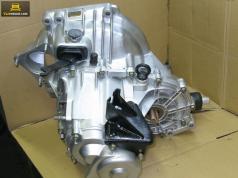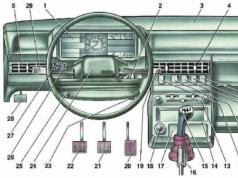Sometimes the car ceases to please its owner. This happens when it starts to break.
One of the car breakdowns is the interior heater of the VAZ 2110, which must be properly disassembled and assembled. After disassembling this mechanism, you can start repairing or replacing it.
In general, on the VAZ 2110, the interior heating system is a complex design, but it can be adjusted and repaired by hand.
Replacing the heater

To perform this operation, you need to know and be able to do the following:
- The car must be prepared for the repair process, removal of parts, mechanisms and other parts.
Note: The vehicle must be parked on a level road surface. Repair should not be carried out without special wheel stands that will hold the vehicle in place.
Also, you need to take care of the hand brake, which must be turned on. Do not forget about the ignition key, which must be taken with you.
- After installing the car, its preliminary preparation, it is necessary to disconnect the negative terminal from the storage battery.
- Using a special box wrench with the number “12”, slightly loosen the nut securing the wire terminal. This operation must be carried out with a negative output. The terminal is removed from the battery.
- The decorative trim for the engine must be removed.
Removing the decorative strip
Note: since the VAZ 2110 car has several engine options, it is necessary to describe the dismantling of the decorative lining on both engine options.
So:
- Engine 2112 (1,5і) - it is necessary to unscrew 4 fastening nuts using a socket wrench with the number "10", which attach the plastic cover to the cylinder head cover.
- The oil filler head has a cover that must be unscrewed and removed.
- The plastic cover is removed.
- Engine 21124 (1,6і) - requires the removal of four fasteners, which are made of rubber. They protect the cylinder head cover.
- The plastic engine cover is removed with a slight upward movement of the hand. Together with the lid, the fasteners are also detached, you should be extremely careful not to lose them.
Draining coolant and filling with new fluid
So:
- After removing the decorative lining of the engine, it is necessary to drain from the vehicle system.
Note: to carry out this work, it is necessary to prepare a container into which the liquid will be drained. Its volume should not be less than 8 liters.
For this procedure, you will need to install the car on an overpass or inspection pit. It is better to install the car before starting work.
- The mudguard is removed from the engine.
- The key with the number "10" on the front fastening of the mechanism removes five nuts.
- There are also three screws that act as a fastening to the car mudguard with engine mudguards.
- The two bolts located at the rear of the mudguard must be removed.
- The mudguard is lightly removed from the engine and vehicle.
- The expansion tank plug is removed from its position by simple translational rotational movements.
- A previously prepared container is installed under the drain nozzle. Its capacity should not be lower than 8 liters.
- The lid is unscrewed with the same rotational translational movements. The coolant is drained.
- The next vessel must be placed under the cylinder block. It is located near the clutch housing at the front of the vehicle.
- A socket wrench with the number "13" is used to unscrew the plug. The coolant remaining in the mechanism is drained.
- The drain plugs that have been unscrewed must be reinstalled.
- Fresh coolant is poured into the tanks.
- There is a top mark on the tank. The liquid must be poured until it touches the mark. After all the plugs are twisted, the engine starts and it operates at increased speeds until the electric fan is turned on.

Note: It is forbidden to mix coolant of different brands and manufacturers.
- After the fluid is drained, work must be done to disconnect the throttle valve.
- The first step is to disconnect the air supply hose.
- The tightening of the two clamps is loosened. The air supply hose to the throttle valve is removed.

- With the accelerator pedal pressed, check the condition of the damper, it must be fully open. When you release the gas pedal, the damper becomes clogged.
- The throttle cable must be completely removed.
- A slotted screwdriver is used, which, by prying the spring, frees it from the sector.
- To remove the cable, turn the sector counterclockwise to the maximum and pull out one end of the cable.
- disconnected from the drive block.
- The actuator is being depressurized.
- The seat cushion (rear) is dismantled.
- To remove the hatch cover, you need to remove two screws with a Phillips screwdriver.
- The manhole cover is detached.
- The fuel module is released from the harness block.
- After turning on the starter, it is necessary to rotate the crankshaft within 15 seconds.
Note: if the engine starts, you must wait until it stops by itself.
- The ignition should be turned off.
- The terminal block is attached to the fuel module.
- The hatch cover is installed in its original place and secured with screws.
- The rear seat cushion is reinstalled.
- The filter is dismantled (the one used in the air supply system).

- It is necessary to loosen, but do not completely unscrew the two clamps. They attach the crankcase breather hose and the air inlet hose.
- The air intake is bolted to the vehicle body. It must be removed.
- Disassembled three struts made of rubber front and rear.
- The housing is removed with sensors, hose and air intake.
- After completing these steps, it is necessary to disconnect the wiring block from the idle speed controller.
- The latch, which fulfills its role, fixes the wiring harness, must be released.
- The block is disconnected from the idle speed regulator.
- Using a Phillips screwdriver, loosen the clamps that secure the crankcase ventilation hose. Two of the three hoses supply the coolant, the third one supplies the adsorber.
- The crankcase ventilation hose is removed from the valve body (throttle).
- The adsorber hose is removed from the throttle assembly.
- Using a wrench with a stroke of 13 millimeters, the two nuts of the throttle assembly are unscrewed into the flange of the intake mechanism.
- The throttle assembly is mounted on studs, from which it must be removed. After shooting, it is raised above the expansion tank of the car's cooling system.

- Leaving the assembly in this position disconnects the hoses. Through these hoses, the coolant is supplied to the mechanism.
- M10 bolts are installed in the hoses (one in each). To prevent them from falling out, it is necessary to tighten the clamps.
Note: the choke assembly is assembled and assembled in the opposite order.
- The next step is to remove the wiper.
- The radiator steam hose must be removed.
- The steam hose is pushed into the lining of the engine compartment.
- A Phillips screwdriver is used to help loosen the screw that connects the motor upholstery.
- The left side of the upholstery is removed.
- The steam outlet hose is connected to the expansion tank. This will help keep the coolant in the machine.
- Here is the rubber strap that secures the expansion tank. The tank moves slightly to the side. Leave the hoses in the same place.

- Using a wrench, unscrew the nut that secures the wiper arm shaft.
- A similar operation is carried out with another wiper arm.
- The fixing bolt of the geared motor to the bracket must be removed.
- The terminal block is unscrewed and removed.
- The wiper arm is carefully removed. There is a possibility of damage to the frame, therefore it is necessary to pay maximum attention to this process.
- Using a socket wrench with a stroke of 10 millimeters, the nut of the upper fastening of the protective screen and the nut of the lower similar fastening are unscrewed.
- The hose holder is detached from its position with a slotted screwdriver.
Note: for cars with hatchback and station wagon bodies, there are three more steps to complete.
- The rear window washer electric pump outlet has two wires that must be disconnected.
- The tank fastening belt is disconnected.
- The tank itself is dismantled and removed from the car.
- The right side of the upholstery is removed.
- The heater wiring harness has a clamp that keeps them in one pile. You need to eat it with nippers.
- Having made the release of the latch, the pads of the electrical wires are disconnected.

- The same operation takes place with the wires of the flap position sensor and the heater flap.
- A Phillips screwdriver is used to loosen the radiator hose clamp. Subsequently, the hose is removed from the radiator pipe.
- The lower hose is disconnected using the same technology.
- The fastening nut on the right side is unscrewed.
- The nut of the lower left fastening follows the previous one.
- The top mount is removable.
- The same happens with the other top mount.
- The heater is removed from the car with successive movements.
The heater is installed in the opposite sequence. Information on the implementation of this work can be viewed in the maintenance service to the car or on the Internet, by watching a video or even a photo.
For the first repair, you must use pictures that will help you do this work with your own hands. The main thing is to do everything as required by the instructions.
In this case, there will be no problems. And even so, you can save quite a lot, because the price of services of this kind is not cheap.







